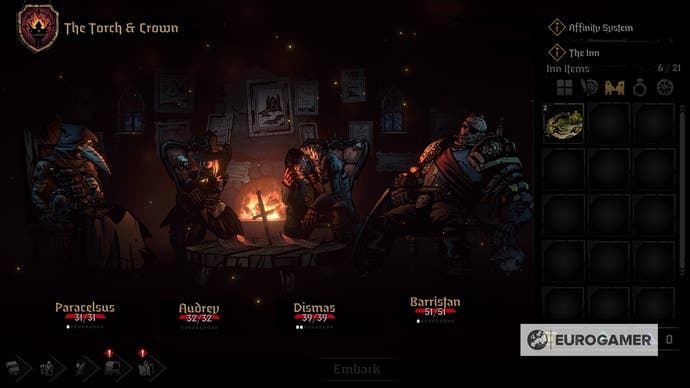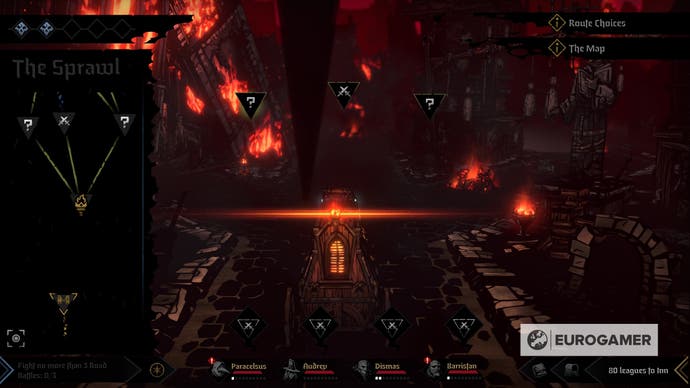Darkest Dungeon 2 is more of a Rogue-like than the original, and it's transformative
Dismas be love.
Darkest Dungeon 2 has made some quite profound changes, and I wasn't sure about them at first. I think they annoyed me. But in going back to the original to refamiliarise myself, it made me see them differently - isn't it funny how our minds can idolise things to the point of infallibility? I thought very highly of Darkest Dungeon. But by seeing it laid bare, I see the sequel better, and now, I'm a fan.
It's all about the carriage - that's the big change. It's a wooden thing pulled by a horse, very much like the carriage in Darkest Dungeon's opening sequence. And this time it's your home. You no longer have a static base. That hamlet on the hill that you rebuilt in DD, that's gone. Now you live life on the road.
Immediately, you'll notice this gives the game a more cinematic look. The carriage sections are 3D - a first for the series - and you steer it through areas that change depending on your mission. There are cursed farm landscapes where bulging flesh grows like parasites on crops, there are cities aflame like hellish infernos, and there are towns turned to graveyards, where flayed corpses hang like dirty washing on lines. It's impressively atmospheric, and as grotesquely horrible as Darkest Dungeon ever was.
The second thing you'll notice, in time, is the carriage changes the shape of the game. Darkest Dungeon 2, in some senses, is a Rogue-like. You get one attempt to see how far you can take your carriage. You pick your team at the beginning, at the Crossroads, and if any of them die along the way, that's it, no substituting them - not as far as I've seen, anyway. And if you all die, it's back to the beginning again.
The carriage changes how the game progresses moment to moment, too. In the old game, you walked along hallways in dungeons and into rooms. Here, you ride along roads or tracks, and these are presented as either-or decisions, a bit like the map in Slay the Spire - sorry to use that reference again but I hope most of you know it. You see the routes and sometimes what you'll encounter on them, and then junction by junction, you choose where to go.
 Let's Play Darkest Dungeon 2 - THE END IS HERE! Darkest Dungeon 2 Gameplay, Reaction, & Early Access
Let's Play Darkest Dungeon 2 - THE END IS HERE! Darkest Dungeon 2 Gameplay, Reaction, & Early Access
Because there's no base, the buildings you relied on before are now stops on your route. Merchants, healers, character upgrades - you do that all on the move. My favourite are the new Hero Story moments each character has, broken into mini-chapters, which give a bit of backstory and then unlock a new skill for them (which is permanent and remembered between runs). Occasionally, there are special set-pieces like breaking out of prison or commanding armies, or facing a drunken, abusive husband. They are intriguing glimpses at who these ruthless fighters once were, and you can also fail them and receive no reward.
Another interesting new stop, one you'll rely on, are Supply stops, when you'll be confronted with miserable survivors - The Desperate Few - and choose what to do with them. Each of your party members will have an opinion, as they will at all stops, and you choose whose to go with. Maybe you'll be nice and give away currency in return for torchlight and food, or maybe you'll rob them and put them out of their misery, and take everything instead. But siding with one character usually antagonises another character, and relationships require careful consideration, as in Darkest Dungeon. Let them foul and characters will refuse to help each other in pivotal moments in battle. Encourage them and they'll step in to help each other, performing automatic combos that can turn the tide of battle.




But the most important stop is the inn. This usually bookends a mission. It's where characters rest and do things like use special collected 'inn items' like dartboards to lower stress and improve inter-party relations, and where they heal and upgrade skills using hard-earned Mastery points. You can also upgrade your carriage to hold more, or produce other buffs and effects.
I like the carriage now. I didn't when I began. I thought it drew the action out and made the game experience longer than it needed to be. I also thought it was a pig to control, which I still think - steering it is like playing a sluggish OutRun - but I've gotten used to it, and I've changed my mind about the carriage slowing the game down. I actually now think the opposite. I think it breathes a sense of energy into the game. It creates this feeling that things are always moving, always going forwards. In Darkest Dungeon you walked, and the difference in pace is really noticeable.
Moreover, the carriage as a mechanic declutters the game and speeds the experience of playing up, even if it does take a while to rumble along the roads. All the busywork in-between has gone. Whereas before you would spend a lot of time roster-managing and carefully considering who to take on a mission - based on who was well enough, whether they were high level enough, and then working out if you had enough money for torches and food - now, you just go.
There isn't a roster. You have a selection of characters, which gradually widens, and that's all you need to think about. They'll be there again when you try again. Torches aren't a thing any more. Torchlight is - you have it on your carriage and if it dims, the game gets harder - but you top it up simply on Supply routes. Food doesn't interfere as much now either. You don't have to eat as you travel, I don't think, only at inns. This means you don't lose health if you travel without food. In fact, you slightly gain health as you travel instead, which is enormously helpful. Stress has been simplified too. There are no numbers, only pips on a gauge.

This all makes Darkest Dungeon 2 much more of a 'one more go' kind of game, because nothing piles up in between attempts. There's no getting entrenched in a complicated saved game. You wipe the slate clean each time and try again.
That doesn't mean Darkest Dungeon 2 is any easier. That punishing and defining difficulty is still there. There's still a warning at the beginning of the game to prepare you for it, for the inevitability of dying again and again before experiencing anything like meaningful progress. And yes, this bears out. I have completed about two missions in several hours, and I've run away from more fights than I've sought. It's frustrating.
But if you can settle into the game's remorseless, that's where you'll find the magic. This isn't a game about being heroic, it's a game about surviving and scraping through. It's a game about learning to value any advantage, and to not get sloppy or overconfident in your approach. And when you begin to appreciate that, you begin to appreciate it. And you begin to see beyond the bigger and better - the more glamorous artwork, the fancier animations, the cinematic flair - into a game that seems to have trimmed an already strong concept into something leaner and potentially even meaner than before.









